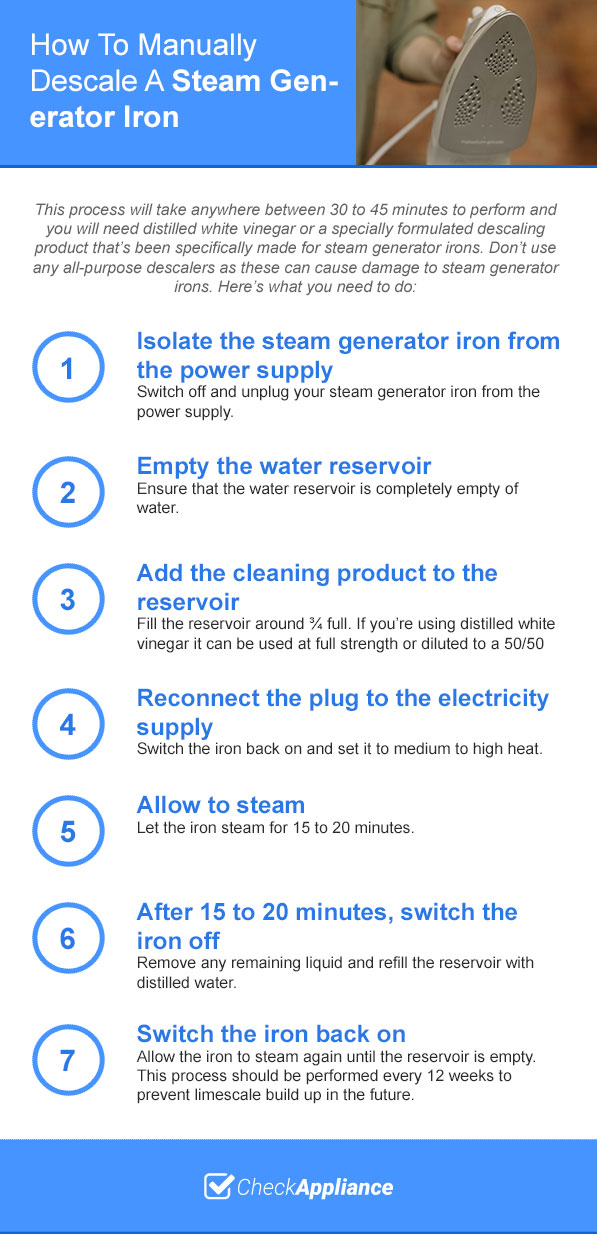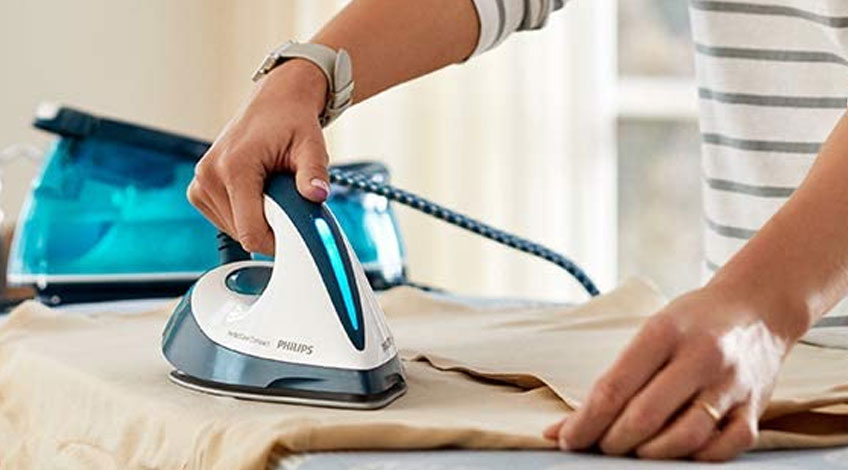
How To Descale A Steam Generator Iron
If you’ve noticed your steam generator iron isn’t working as well as it used to. It doesn’t necessarily mean it’s time to buy a new one, it could just be that your steam generator iron needs descaling. We often jump to the worst case conclusion before checking out more simple causes.
With steam generator irons if you notice any of the following, it probably needs descaling;
- Significantly less, or no steam production
- The iron doesn’t remove as many creases as it used to
- There’s a brown or white residue left on clothes after being ironed
- The iron seems to stick on clothing instead of gliding effortlessly
If you have noticed any of these issues, there’s a very good chance your iron needs descaling.
If you don’t deal with it soon, you’re going to eventually need to replace the iron, and descaling is such an easy task to perform. It takes little to no special equipment and you’ll probably already have any products needed at home already.
How To Manually Descale A Steam Generator Iron

This process will take anywhere between 30 to 45 minutes to perform and you will need distilled white vinegar or a specially formulated descaling product that’s been specifically made for steam generator irons. Don’t use any all-purpose descalers as these can cause damage to steam generator irons.Here’s what you need to do:
- Isolate the steam generator iron from the power supply
Switch off and unplug your steam generator iron from the power supply. - Empty the water reservoir
Ensure that the water reservoir is completely empty of water. - Add the cleaning product to the reservoir
Fill the reservoir around ¾ full. If you’re using distilled white vinegar it can be used at full strength or diluted to a 50/50 solution. - Reconnect the plug to the electricity supply
Switch the iron back on and set it to medium to high heat. - Allow to steam
Let the iron steam for 15 to 20 minutes. - After 15 to 20 minutes, switch the iron off
Remove any remaining liquid and refill the reservoir with distilled water. - Switch the iron back on
Allow the iron to steam again until the reservoir is empty. This process should be performed every 12 weeks to prevent limescale build up in the future.
How To Descale The Iron’s Soleplate
Limescale can also build up on the soleplate of the iron away from the steam holes. This prevents the iron from operating correctly and in some cases stops the steam from passing onto the clothing properly. This is an easy fix fortunately and can be done in the following way;
- Fill a bowl or tray with 1 inch (2.5cm) of distilled white vinegar
Using a shallow tray, pour just enough distilled white vinegar to cover the iron’s soleplate into the tray. - Place the iron on the tray
Ensure that the soleplate is completely immersed in the vinegar. - Leave for 45 to 60 minutes
Allow the vinegar to soak into the limescale for around ¾ to 1 hour. - Remove the iron from the bowl
After the correct time has elapsed, remove the iron from the vinegar and gently brush across the soleplate and into the steam holes. Then wipe with a damp cloth.
This should have removed all of the limescale from the soleplate of the iron, it might be necessary to repeat if there was a heavy buildup that hasn’t been removed the first time.

Steam Generator Irons With A Built-In Descaler
Before descaling your steam generator iron, check the manufacturer’s instructions to see if your model has a built-in descaler. If it does, don’t descale it manually as doing so could damage your iron and invalidate any warranty.
With so many brands producing steam generator irons, there are 3 different types of built-in descalers. Each type functions differently. Your iron will either have;
- A descale setting on the iron
To operate this just select the descale program and the iron will effectively descale itself. You will usually be notified via an indicator light when a descale is needed. Some steam generator irons descale settings can remove all limescale in under 2 minutes. All that you need to do is allow the expelled water and limescale to cool down before pouring it down the drain. - Descaling cartridges
These descaling cartridges remove minerals from the water to prevent limescale residue. The cartridges need replacing regularly. - A Limescale collector
This is a container found within the water reservoir that collects these mineral deposits. It will need emptying and cleaning every 12 weeks or so.
If your steam generator iron has a built-in descaler, check your user manual for how to correctly use and service these features.
What Causes Limescale?
Limescale is formed from the various minerals left behind when hard water evaporates. It can range in colour between white to pink, red and brown depending on which minerals are present. In addition to looking unsightly, limescale can cause serious damage to your iron.
What Is Hard Water?
When it rains, the water that falls from the sky would be considered to be soft water. As it passes through the rocks on its way to underground aquifers, it picks up minerals from the rocks which get carried with the water and accumulate at the point of evaporation.
Where Is Hard Water Found?
Hard water is found wherever rain water seeps through deposits of limestone, chalk or gypsum. In the UK almost 60% of all tap water is considered to be hard water. In the US it’s more like 85%.
How To Prevent Limescale Buildup
To prevent the buildup of limescale in your iron or at least slow down its formation, use distilled or demineralised water when filling the iron. As this water is purified it is virtually mineral free. You can use filtered tap water but this always contains more minerals than distilled water.
To prevent the soleplate of your iron from becoming dirty or the steam holes blocked, always wipe the soleplate down using a soft sponge after every use once the iron has cooled down completely.
Always empty the water reservoir after each use, never leave water in the reservoir to evaporate. If the water evaporates it will leave limescale residue, which is what we’re trying to avoid.
Iron your garments at the correct temperature as indicated in the garment’s label. When ironing clothes at too high a temperature, it is possible to melt small pieces of dust onto the soleplate. This melted dust starts to block the steam holes which will then create places ideal for the formation of limescale.
Frequently Asked Questions
Before using a descaler in your steam generator iron, check in the manual, because many of the modern steam generator irons have built-in descalers. If your model doesn’t have a built-in descaler we recommend using either a dedicated steam generator iron descaler or distilled white vinegar and not a generic product.
If there is brown water coming out of your steam generator iron, you have a buildup of limescale in the water. It’s time to clean out the reservoir and descale it.
If your iron is spitting out brown or white liquid it is caused by a buildup of limescale and needs to be descaled. The limescale can vary in colour from white, pink, red or brown depending on the minerals present in the water.
Also, follow us on Pinterest ...



